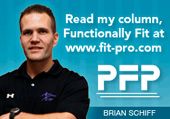Brian Schiff’s Blog
Injury Prevention, Sports Rehab & Performance Training Expert
The longer I work with clients, the more hip issues I see. Generally speaking, I find the major issues to be related to decreased mobility, poor stability and muscle imbalances. These may occur in isolation or combination.
It is a no-brainer that most people have tight hip flexors and external rotators given all the sitting that takes place in our computer age. This inherently creates weakness and tightness. I feel that a natural propensity to be positioned in hip external rotation may actually reduce the firing of these muscles which in turn allows for more valgus moments at the knee and reduces lower limb stability.
Typically, female athletes fail to adequately fire the gluteus maximus (hip extension and external rotation) and prefer to dominate movement with the quads. So, how do we begin to change this?
Well, first we must focus on better hip mobility. I believe we must work to gain better hip extension by stretching the hip flexor group. I also believe we need to do this dynamically and not just passively. A dynamic approach also allows us to improve knee stability on the opposite side as we work on hip mobility. It will also allow us to resist internal rotation of the femur and the valgus moment at the forward knee.
Look at the images below:
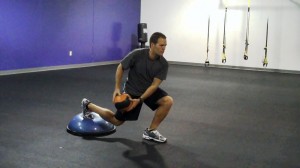
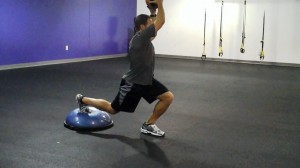
I am demonstrating a BOSU split squat diagonal chop. This is the first of a series of BOSU exercises I am doing for PFP Magazine. The upward chop forces hip extension on the right side and the downward motion reinforces firing of the left glutes to reduce internal rotation and valgus. What a perfect combo right?
To read more about this exercise, click here.
Now, you should start on the floor with just the arms and progress from there. This is a great prehab exercise or warm-up activity, but it cna also be used for strengthening too. I hope you find it as beneficial in your routine as I do.
Over the years, I have worked with hundreds of athletes (male and female). One consistent finding among many I see is weakness in the hips and core. Knee injuries are often the result of poor frontal and transverse plane stability, which is often related to weakness in the glutes (max and medius).
In order to resist valgus/rotational loads effectively, athletes must address this weakness with training. I am always looking for ways to get the most out of exercise provided it makes sense to me. So, I began using the exercise I am sharing with you today – BOSU planks with hip abduction/extension. I use both to work on the gluteus maximus and medius muscles. This exercise targets hip and core weakenss at the same time.
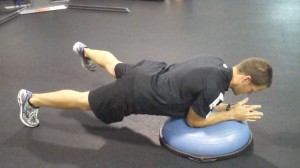
Hip Abduction
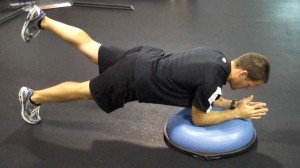
Hip Extension
Click here read how to execute the exercise and apply it to your routines.
I hope you enjoyed part one in this series. Part two looks at a frontal and transverse suspended reach. This is a great way to train the body to better resist shear forces that are encountered in sport.
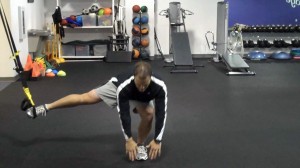
To read more about this progression and see the rotational component, click here. This exercise is a great way to improve hip strength and improve de-rotational capacity, thereby reducing injury risk with planting, cutting and pivoting.
Throughout my speaking and training, I advocate single leg strengthening. Additionally, I try to incorporate balance and stability training progressions that target common muscle imbalances and reduce injury risk.
It is common knowledge that the hip can often affect the knee. Likewise, the foot and ankle complex can also impact the knee. Single leg training often exposes and corrects limb deficiencies and simulataneously improves function and performance.
I have been producing a TRX functionally fit mini-series for PFP magazine. The first two editions focus on single leg suspension reaching progressions. I thought I would share those with you as there may be portions you can apply to your own training or to others.
I use these progressions with runners, court and field athletes, and general clients alike. They work the entire kinetic chain and emphasize anti-gravity control in multiple planes. These progressions can be part of an advanced rehab regimen or fitness program. Below is a picture of the phase one sagittal plane reach:
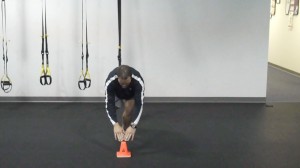
To see the entire progression (part 1), check out my column by clicking on the image below.
It is no secret that Americans are trying to stay more active well into their baby boomer years and beyond. The million dollar question is how will what you do today affect your joints down the road.
Scholars, scientists and medical experts do not seem to agree 100% on what is too much, but most tend to agree that excessive running, obesity, irregular or unusually intense activity (think weekend warriors here), muscular weakness and even decreased flexibility may all contribute to arthritis.
The New York Times recently ran a story about the cost of total joint replacement and suggestions on how people can be proactive to reduce the risk and debilitating effects of arthritis. Click here to read the article.
I think one of the most amusing yet ironic things about science is that it often contradicts itself. Obviously, we know being overweight increases stress on the load bearing joints. Most people would also knowingly acknowledge that improved strength and flexibility would make for healthier knees and hips.
The big question mark for me is impact loading, or simply the argument of whether to run or not to run. Some docs say no way. Others say yes. Yet others offer more ambiguous words on the subject. So, what do I think?
I honestly believe there may be no absolute answer. I am not convinced running on a treadmill is all that much better for you as some would suggest either. My body tells me blacktop surfaces are better than cement sidewalks, while the soft earth is better yet still. I use the treadmill in the winter and for speed work but if you run events too much treadmill work will let you down on race day as the body is ill prepared.
Much like exercise prescription, I think joint loading and tolerance is a very individual matter indeed. Biomechanics, posture, training history, medical history, repetitive movements, footwear, nutrition, body type, recovery, etc are just a few of the variables one must consider when passing judgment on exercise prescription and limits.
Beyond that, the best indication to reduce or remove an activity for a short bit or long term is obviously pain. But before doing so, one must correctly identify the source of the pain. At times, the pain may seem like a joint issue when in fact it could simply stem from poor muscle recruitment, lack of mobility or faulty movement patterns thereby subjecting joints to undue stress.
I say all this to say we must be careful in saying one should not do something definitively. Some folks run well into their 80’s without issues. Others break down after one endurance event. In the end, we must face facts. The human body is complex and no two people are exactly alike. I had left hip pain years ago that felt like arthritis. My orthopd told me the x-ray showed a few mild bone spurs and mild hip dysplasia.
His advice? Quit running. I did for 6 months and the pain did not subside. So, I began a progressive running program and changed up my strength training to more single leg based work. Guess what? My pain went away 100%. This tells me the impact itself was not likely the cause of my pain, but more likely a muscle imbalance that I overcame through more efficient strength training.
We must look at science, anecdotal findings and clinical experience to pull out general patterns and thoughts all the while continuing to use assessment, feedback and results to lead us to the best conclusion for each client, patient or athlete. You must use all this information to make the best decision for your situation as well.

